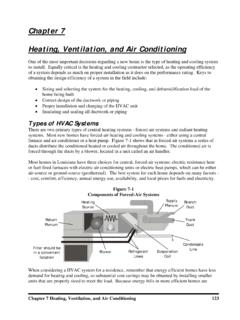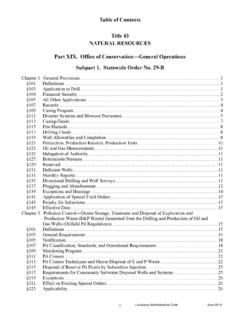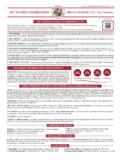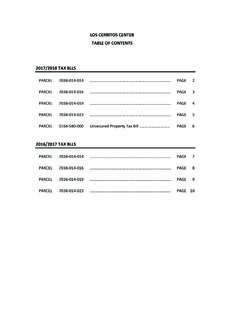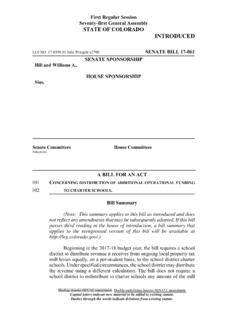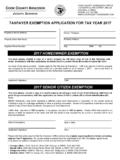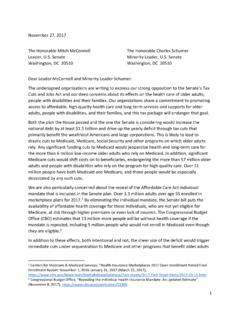Transcription of LOUISIANA SEVERANCE TAX
1 Department of Natural Resources 1 Technology Assessment Division LOUISIANA SEVERANCE TAX (The following is the Technology Assessment Division summary of the law. For legal definition look them up in the LSA at the indicated statutory citation.) SEVERANCE tax is levied on production of natural resources taken from land or water bottoms within the territorial boundaries of the state. The state collects no SEVERANCE from production in federal waters in the Gulf which start three miles from the LOUISIANA coast line. Natural resources are all forms of timber, including pulp woods, and turpentine and other forest products; minerals such as oil, gas, natural gasoline, distillate, condensate, casinghead gasoline, sulphur, salt, coal, lignite, and ores; also marble, stone, gravel, sand, shells, and other natural deposits; and the salt content in brine.
2 Oil and gas collections account for almost 92 percent of all SEVERANCE tax collections. Because of the significant revenues generated, the focus will be centered on the oil and gas SEVERANCE tax is paid by the owners of the natural resources at the time of SEVERANCE . Tax Rates The capable tax rate for oil and condensate is percent of value and ac-counts for over 85 percent of the oil and condensate tax collections. There is al-so an incapable rate and a stripper rate for low-producing oil wells. The current oil SEVERANCE tax rates are listed the Oil SEVERANCE Tax Rates page. Historical oil rates are listed in the Historical Oil SEVERANCE Tax Rates page. The capable rate for gas, for fiscal year 2008-2009 is per MCF, is responsible for over 91 percent of total gas tax collections.
3 There are also reduced tax rates for low-pressure oil-well gas and incapable gas-well gas. The current SEVERANCE tax rates are listed in the Gas Tax Rates page. Historical gas rates are listed in the Historical Gas SEVERANCE Tax Rates page. Types of SEVERANCE Tax Exemptions SEVERANCE tax exemptions for oil, gas, and minerals are in the form of exclu-sions, exemptions, deductions, and suspensions. Exclusions are by statute and refer to specific categories of natural gas upon which the tax shall not accrue. Exemptions and suspensions are also statutorily mandated and exempt or sus-pend the tax on oil or gas severed from wells that meet certain criteria. Deduc-tions are defined as a credit against or a reduction to the taxable base.
4 Department of Natural Resources 2 Technology Assessment Division OIL SEVERANCE TAX RATES (The following is the Technology Assessment Division summary of the law. For legal definition look them up in the LSA at the indicated statutory citation.) 1. Oil Full Rate STATUTORY CITATION: 47:633(7)(a) 12-1/2 % of its value at the time and place of SEVERANCE . It has not changed since 1974. For previous tax rate see Historical Oil SEVERANCE Tax Rates page. 2. Incapable Oil Rate STATUTORY CITATION: 47:633(7)(b) 6-1/4 % of its value. Oil produced from a well that is incapable of pro-ducing an average of more than twenty-five barrels of oil per day during the entire taxable month, and which also produces at least fifty percent salt water per day.
5 On multiple well leases all wells must meet the crite-ria to be able to qualify for the exemption. 3. Stripper Oil Rate STATUTORY CITATION: 47:633(7)(c) 3-1/8 % of its value. Oil produced from a well that is incapable of pro-ducing an average of more than ten barrels of oil per day during the entire taxable month. 4. Reclaimed Oil Rate STATUTORY CITATION: 47 3-1/8 % of its value. Reclaimed oil which has been reclaimed by class one salvage crude reclamation facilities which are permitted by the Of-fice of Conservation - 3-1/8% of value received for the first purchase. Any person or affiliate of a person engaged in severing oil, gas or other natural resources, or operating oil or gas property, or other property from which natural resources are severed, shall not be eligible for the reduced tax rate.
6 5. Condensate Rate STATUTORY CITATION: 47:633(8) 12-1/2 % of its value at the time and place of SEVERANCE . Department of Natural Resources 3 Technology Assessment Division HISTORICAL OIL SEVERANCE TAX RATES The first tax, based on the SEVERANCE of oil was imposed in 1910. This tax was levied as an occupational license tax at a rate of 2/5 per barrel of oil. There have been many changes in the tax rates since 1910, including fluctuations from a volumetric to a percentage-of-value based tax. The changes are listed below in chronological order 1910 Oil and condensate 2/5 per barrel 1912 Oil and condensate of gross value less royalty interest 1920 Oil and condensate 2% of gross value 1922 Oil and condensate 3% of gross market value 1928 Oil and condensate 4 -11 per barrel depending on gravity 1940 Oil 6-11 per barrel depending on gravity; condensate 11 per barrel 1948 Oil 18-26 per barrel depending on gravity.
7 Condensate 20 per barrel 1974 Oil and condensate of value Department of Natural Resources 4 Technology Assessment Division GAS SEVERANCE TAX RATES (The following is the Technology Assessment Division summary of the law. For legal definition look them up in the LSA at the indicated statutory citation .) 1. Gas Full Rate STATUTORY CITATION: 47:633(9)(a) The adjusted SEVERANCE gas full rate is: from July 1, 2016, through June 30, 2017 , is cents per MCF, from July 1, 2017 , through June 30, 2018, is cents per MCF. Previous year tax rate see Historical SEVERANCE Gas Tax Rates page. 2. Incapable Oil Well Gas STATUTORY CITATION: 47:633(9)(b) 3 cents per MCF for gas produced from an oil well, which has a wellhead pressure of fifty pounds per square inch gauge or less under operating conditions.
8 To qualify for the reduced rate an oil well must have a casinghead pressure of fifty pounds or less per square inch for the entire taxable month. 3. Incapable Gas Well Gas STATUTORY CITATION: 47:633(9)(c) 1-3/10 cents per MCF for gas produced from a gas well, which is incapa-ble of producing an average of 250,000 cubic feet of gas per day. To qualify for the reduced rate a gas well must be incapable of producing 250,000 cubic feet of gas per day during the entire taxable month. 4. Contract Rate STATUTORY CITATION: 47 (C) Gas sold under a written agreement requiring seller to pay tax without any reimbursement or with less than fifty percent reimbursement: { 3 cents per MCF for gas sold under a contract, in existence prior to May 1, 1972, at a price less than the Federal Power Commission (FPC) authorized area rate, which requires the seller to pay and bear all of the SEVERANCE tax without reimbursement of any portion of it.}
9 { 4 cents per MCF for gas sold at a rate less than that authorized as the area ceiling or-dered by the FPC in opinion nos. 598 and 607, under contracts in existence prior to No-vember 25, 1973, which require the seller to pay and bear more than fifty percent of any increase in SEVERANCE tax. { Not to exceed 7 cents per MCF for gas sold at a rate less than fifty-two cents per MCF under contract prior to July 1, 1970. This rate is effective for the duration of the contract, whether or not such contract has been amended or supplemented subsequent to July 1, 1970, provided that the gas is sold for less than the prices previously specified.}}
10 Department of Natural Resources 5 Technology Assessment Division HISTORICAL GAS SEVERANCE TAX RATES The first tax, based on the SEVERANCE of gas was imposed in 1910, The gas tax rate was 1/5 cents per 10,000 cubic feet or 10 MCF for gas. Act 140 of 1922 carried into effect a 1921 constitutional authority for a SEVERANCE tax. There have been many changes in the tax rates since 1910. Act 387 of 1990 amended the gas SEVERANCE from a base tax rate to one that will be adjusted annually thereafter by an index (gas base rate adjustment). This indexed rate became ef-fective on July 1, 1990. The changes are listed below in chronological order. 1910 1/5 per 10 MCF 1912 of gross value less royalty interest 1920 of gross value 1922 of gross market value 1928 1/5 per MCF 1936 3/10 per MCF 1958 per MCF 1972 per MCF 1974 per MCF July 1990 per MCF, indexed annually July 1991 per MCF, indexed annually July 1992 per MCF, indexed annually July 1993 per MCF.
